A prehabilitation program at The Queen Elizabeth Hospital is allowing patients with lower limb amputations to return to the comfort of their own home sooner, cutting their average time they stay in hospital by close to two weeks.
This innovative program, run by the TQEH Day Rehabilitation Service was recognised for its positive patient outcomes being named as the winner of the Out of Hospital Strategies and Care category at the recent SA Health Awards.
Prehabilitation is a multi-disciplinary process preparing patients for their recovery post-surgery.
It involves education and physical conditioning to prepare for major lower limb amputation as well as assessing the home environment to facilitate discharge home directly from the hospital.

Patient Patricia Peterson was discharged straight to home five days post-surgery.
Senior Occupational Therapist Shelley Fulton said patients reported less fear and stress about an upcoming operation.
“Prehabilitation is the process that enhances an individual’s capability to withstand forecoming stressors such as surgery,” Shelley said.
“For planned lower limb amputations, prehabilitation should be the default pathway.”
While the project is still in its infancy, Shelley said the program has the potential to create a best-practice example that could be replicated and could have wider cost-savings across SA Health.
Six out of the seven patients who have attended the Prehabilitation program have been discharged directly home from the acute hospital, avoiding the need for inpatient rehabilitation and potential hospital acquired complications.
“On average the Prehabilitation project has improved the amputation journey for patients, reducing their acute average length of hospital stay from 33 days to 11.”
Patients are also reporting the benefits of having the same rehabilitation team before and after their amputation.

Patricia Peterson, bottom left, and the team at Day Rehabilitation Service.
Pat, 58, received an amputation on her left leg after being diagnosed with bone infection. She only stayed in hospital for five days post-amputation and was discharged to go home.
“If I didn’t have prehabilitation, I won’t have known what to do when I got home,” Pat said.
“I couldn’t be discharged from hospital unless I knew how to get from bed to chair and from chair to toilet – and I had two weeks of practice in prehabilitation which makes me more confident about going home.”
Rehabilitation physician Dr Siang Naik, who set up the program, said the prehabilitation team used risk assessments about wheelchair access in Pat’s home. Without this, Pat would have required longer hospitalisation in Hampstead post-amputation.



